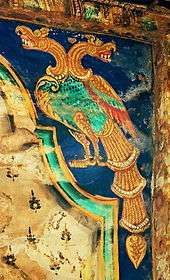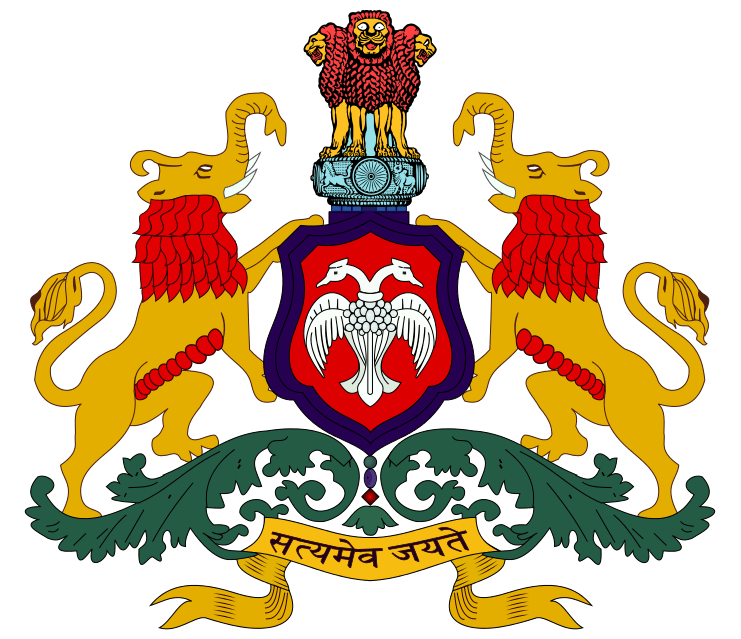Gandaberunda
The Gandaberunda or Berunda (Kannada: ಗಂಡಭೇರುಂಡ gaṇḍabheruṇḍa), or Bheruṇḍa (Sanskrit: भेरुण्ड, lit. terrible) is a two-headed bird in Hindu mythology, believed to possess immense magical strength. It was the emblem of the erstwhile Kingdom of Mysore under the Wodeyar kings, and after India attained independence, it was retained by Mysore state as its emblem. That state was enlarged in 1956 and renamed Karnataka in 1973, and the Gandabherunda continues to be the official state emblem of Karnataka. It is used as the official emblem of the Karnataka state government because it is a symbol of strength. It is believed to be capable of fighting the forces of destruction. It appears as an intricately carved sculpture motif in Hindu temples.[1]
_in_the_Rameshwara_temple_at_Keladi.jpg)

Depiction
The bird is generally depicted as clutching elephants in its talons and beaks, demonstrating its immense strength. In a coin [Kasu] found in Madurai, it is shown holding a snake in its beak.[2] All 2-dimensional depictions show a symmetrical image similar to the Double-headed eagle while other images show the long tail feathers resembling a peacock, which is the national bird of India. In the Chennakeshava temple of Belur, Karnataka, Gandaberunda, the two faced bird is carved as a scene of "chain of destruction" in which a deer becomes prey to a big python, which in turn is lifted by an elephant. A lion attacks the elephant and the lion itself is devoured by Gandabherunda.[3] The Gandaberunda was later identified as a physical form displayed by Narasimha, Man-Lion incarnation of Lord Vishnu. It's mentioned by several Hindu scriptures.
After Lord Narasimha had slain the demon Hiranyakashipu, he clung on to his dreadful form. The Devas were even more afraid of Lord Vishnu than they were of the demon. In order to protect the entire creation, lord Shiva incarnated as Sharabha or Sharabhesvara, a part-lion and part-bird beast. This further angered Lord Narasimha who took the form of Lord Gandaberunda, who fought Sharabha for 18 days.Finally, Gandaberunda defeats and kills Sharabha.[4]
Usage
A sculpture depicting a Gandaberunda is found on the roof of the Rameshwara temple in the temple town of Keladi in Shimoga District, the capital of the Keladi Nayakas. The Gandaberunda was also used by the Wodeyar dynasty of Mysore as the Royal emblem. The Karnataka Government adopted this symbol as the state symbol and can be found on bus terminals and tickets issued by Karnataka State Road Transport Corporation. Coins(Gold pagoda or gadyana) from the rule of Achyuta Deva Raya are thought to be the first to use the Gandaberunda on currency.[5] The crest of the Indian navy ship INS Mysore (D60) features a Gandaberunda.
Emblem
Gandaberunda is the official emblem of Karnataka state government. It was the royal insignia of the erstwhile Mysore kingdom. The Deccan Herald wrote, "When Dasara completed four hundred years this year, another major feature associated with Mysore kingdom, the royal insignia Gandaberunda quietly celebrated 500th year.
The City Herald tried to dig into the roots of the Gandaberunda and stumbled upon some exciting stories associated with it. The Gandaberunda is an imaginary two headed bird. Even five centuries after its first usage in the mints for making coins during the period of Vijayanagar empire around 1510, the Gandaberunda is still flying high as the symbol of seat of power of Karnataka - the official insignia of State.
Though the 400th year of Dasara (which was tipped for the most grand celebrations), did not live up to its expectations, the 500th year of adoption of Gandaberunda received a floral celebration, with a 10 foot flower model of the imaginary bird put on display at the Dasara flower show.
Historian Professor P V Nanjaraje Urs -- who has widely researched Mysore State -- tells that the Gandaberunda was first used as a sign on coins in Vijayanagar mints, many of which still exist. Since then, the tradition passed on to generations. In mid-16th century, legend says that Yaduraya embarked on a Vijaya Yathra across the Mysore State to consolidate their rank. During the Yathra, an ascetic encountered and gave him a red cloth. The King offered pooja to it and accepted it as a blessing. He won all acclaim thereafter."
Following his stature raising to new heights, he announced red cloth as Rajdhwaja or State flag. To add the principles of dharma and satya, the flag got a slogan as "Sathymevodhbhavaramyaham" with imaginary bird Gandaberunda. The bird was surrounded by elephant headed lion on two sides and a lion carrying Mahishasura’s head on the top.
Bengaluru FC, a football club based in Bangalore, has a Gandaberunda in the club crest. Kannada Vedike Cultural Club of National Institute of Technology Karnataka Uses Gandaberunda in their official club logo.
Historically it has been used in the crests and official seals of the:
- Chalukyas
- Chagis
- Kota Kings (Dharanikota Kings)
- Hoysalas
- Keladi Chiefs
- Kadambas
- Nandyalas (Vijayanagara Empire)
- Gobburis (Vijayanagara Empire)
- Wodeyars of Mysore
In media
Ganda Berunda is a Kannada film directed by S. V. Rajendrasingh Babu and produced by Vajramuni. The playwright of the movie was the celebrated writer, late H V Subba Rao. The film was released in the year 1984. The music was composed by Sathyam. Bollywood actor Amrish Puri played the antagonist in the film.
- The Gandaberunda emblem in the Mysore Palace.
 Coat of arms of Karnataka, India
Coat of arms of Karnataka, India Gandaberunda image seen at Lalitha Mahal Palace Hotel, Amsterdam
Gandaberunda image seen at Lalitha Mahal Palace Hotel, Amsterdam
See also
Notes
- "Mystical Bird Gandaberunda". Retrieved 2007-04-12.
- Ganesh Coins of Tamilnadu, 13.48
- "Kamat's Potpourri: Amma's Column - Gandaberunda- The Two Headed Bird". web.archive.org. 2014-02-02. Retrieved 2020-01-23.
- Lalit chugh (2016). Karnataka's Rich Heritage - Art and Architecture: From Prehistoric Times to the Hoysala Period. Nation Press. ISBN 9352068254.
- "The COININDIA Coin Galleries: Vijayanagar". coinindia.com. Retrieved 2020-01-23.
1.Brahma took the avatar of Gandaberunda & not vishnu
External links
| Wikimedia Commons has media related to Gandaberunda. |
- "Evolution of Gandabherunda"-article by S. Srikanta Sastri
- http://digitalcommons.unl.edu/cgi/viewcontent.cgi?article=1001&context=iqsc4symp
- A unique sculpture of Gandaberunda or berunda from Balligavi: